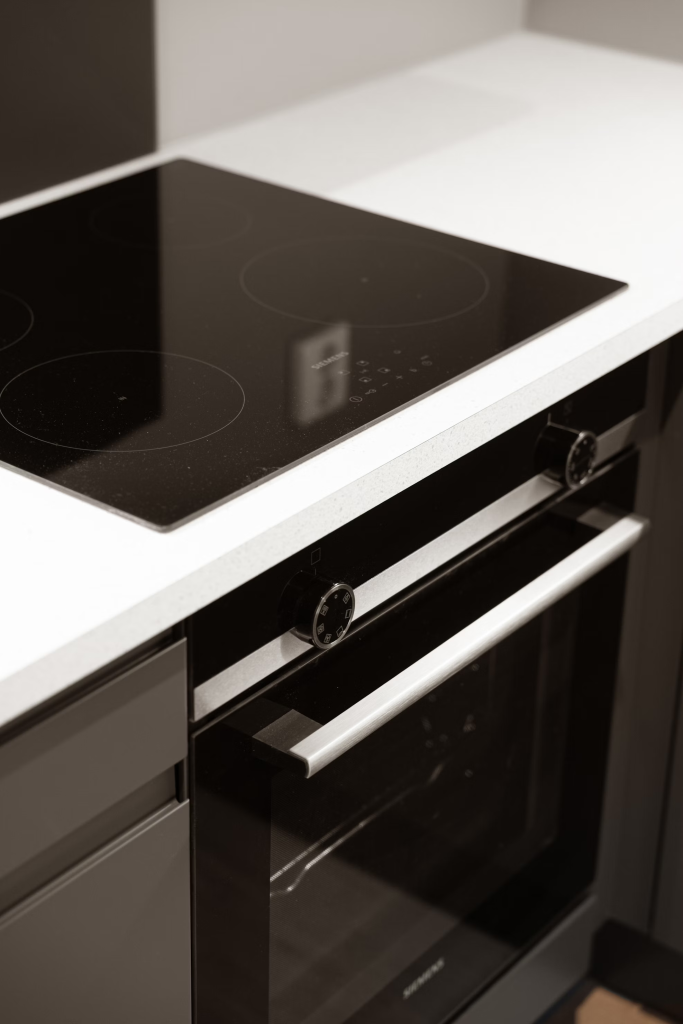Induction cooktops have rapidly gained popularity in Australian kitchens, with many homeowners and chefs alike choosing this modern cooking technology over traditional gas and electric stovetops. Induction cooktops are a form of electric cooking, but unlike conventional electric cooktops, they use electromagnetic energy to heat cooking vessels directly.

This innovation offers a variety of benefits that make them a top choice for both professional and home cooks. In this article, we will explore the many advantages of induction cooktops, including efficiency, safety, ease of use, and environmental benefits.
Click Website For More Details
The Advantages Of Induction Cooktops: A Comprehensive Guide
Energy Efficiency
One of the primary advantages of induction cooktops is their exceptional energy efficiency. Induction cooking works by creating a magnetic field that directly heats the cookware. This contrasts with traditional gas and electric cooktops, where heat is transferred from a burner to the cooking vessel, resulting in heat loss. On an induction cooktop, almost all the energy generated by the electromagnetic field is transferred to the pan, leaving minimal heat wasted.
According to energy efficiency studies, induction cooktops can be up to 90% efficient, whereas gas cooktops typically hover around 50-55% efficiency, and electric cooktops around 70-75%. The ability to use less energy not only saves on electricity bills but also reduces overall energy consumption, making induction cooking an environmentally friendly option.
Faster Cooking Time
Induction cooktops are known for their rapid heating capabilities. The electromagnetic field directly heats the pan, allowing for almost instantaneous cooking. Traditional gas and electric cooktops take longer to heat the burners and subsequently heat the cookware. Induction cooktops, by contrast, allow food to cook faster because the heat is directly applied to the pot or pan.
For instance, boiling a pot of water on an induction cooktop can take just a few minutes, while it might take significantly longer on a gas or electric cooktop. For busy individuals and families, this reduced cooking time can be a significant time-saver, making induction cooking especially ideal for those with fast-paced lifestyles.
Precise Temperature Control
Induction cooktops offer a level of precision in temperature control that is hard to achieve with gas or electric cooktops. With induction cooking, the heat is adjusted instantly when you change the temperature setting. This is because the magnetic field adjusts instantly as well, providing an immediate change in the heat level.
This level of precision makes it easier to cook delicate dishes that require careful temperature management, such as sauces, chocolates, or even eggs. Gas cooktops can sometimes result in uneven heat distribution, while electric cooktops can take longer to adjust to temperature changes. Induction cooktops provide more consistent and responsive temperature control, improving the cooking experience.
Enhanced Safety Features
Safety is one of the main reasons people are switching to induction cooktops. Since the cooking surface itself doesn’t get hot—only the cookware does—induction cooktops are much safer than traditional gas or electric cooktops. This means there is a significantly lower risk of burns or accidental fires.
Additionally, most induction cooktops come with safety features such as automatic shut-off systems, which turn the cooktop off if the cookware is removed, preventing the cooktop from overheating. Child safety locks are also common, allowing parents to ensure their young children do not accidentally turn on the cooktop.
Another safety benefit of induction cooktops is their cool-to-the-touch surface. While a pot or pan may heat up, the surface around it remains relatively cool, reducing the risk of burns from accidental contact with the cooktop. This feature makes induction cooktops ideal for households with children or pets.
Easy To Clean
Induction cooktops are much easier to clean compared to gas and electric cooktops. Since the surface remains cool to the touch (aside from the area directly beneath the cookware), food spills or splatters generally do not burn onto the cooktop. In comparison, gas cooktops often have grates and burners that require regular cleaning, while electric cooktops can accumulate grease or food residue that burns into the surface.
Cleaning an induction cooktop is a simple task, often just requiring a quick wipe with a damp cloth or sponge. For stubborn spots, a glass cleaner or cooktop cleaner can be used to ensure the surface remains spotless. The ease of cleaning an induction cooktop means that time spent on maintenance is minimal, contributing to a more convenient kitchen environment.
Sleek And Modern Design
Induction cooktops offer a sleek, minimalist design that is both functional and visually appealing. The smooth, flat surface fits seamlessly into contemporary kitchen aesthetics, providing a streamlined, elegant appearance. Without knobs or grates, induction cooktops create a clean, uncluttered look, making them a popular choice in modern Australian homes.
Induction cooktops are also available in a variety of sizes and configurations to suit different kitchen layouts. Whether you have a compact kitchen or a spacious cooking area, there is an induction cooktop to meet your needs. Many models also come with touch controls that allow for easy adjustments, further enhancing their modern design.
No Need For Ventilation Systems
Unlike gas cooktops, which require proper ventilation systems to prevent the buildup of harmful gases like carbon monoxide, induction cooktops do not produce any emissions. Since induction cooktops use electricity rather than combustion to generate heat, they are safe to use without any need for a vent hood or an exhaust fan.
This can be particularly advantageous in smaller kitchens or apartments, where installing a venting system may not be feasible. Additionally, this lack of requirement for ventilation reduces the complexity and cost of installation. It also contributes to cleaner air inside the home, which is a health benefit in the long term.
Environmental Benefits
Induction cooktops offer several environmental benefits, primarily due to their energy efficiency and low carbon footprint. As previously mentioned, induction cooktops use less energy than gas or electric alternatives, which means they require less electricity to cook food. This reduction in energy use translates into a decrease in greenhouse gas emissions, particularly if the electricity used is sourced from renewable energy.
Additionally, induction cooktops do not rely on fossil fuels, as gas cooktops do, making them a more sustainable option. By switching to induction cooking, homeowners can contribute to reducing their household’s environmental impact, which aligns with Australia’s efforts to meet carbon reduction targets.
No Need For Special Cookware (In Many Cases)
While it is true that induction cooktops require ferrous-based cookware (i.e., cookware made from materials that are magnetic, such as cast iron or certain stainless steels), many modern cookware sets are induction-compatible. This eliminates the need to purchase special cookware for induction cooking. If your existing pots and pans are compatible with induction, you can start using your new cooktop right away.
For those who need to replace cookware, there is a wide selection of induction-compatible pots, pans, and skillets available in the market. The key is that the base of the cookware must be magnetic, meaning it can interact with the induction field. Fortunately, many high-quality cookware brands offer induction-ready models, and there are affordable options for every budget.
Quiet Operation
Induction cooktops operate more quietly than gas or electric cooktops. Gas cooktops can produce a noisy flame, while electric cooktops often generate a buzzing or humming sound when the coils heat up. Induction cooktops, on the other hand, generally produce little to no sound during operation.
This creates a more pleasant cooking environment, especially in open-plan homes where kitchen noise can be disruptive to other areas of the house.The lack of noise makes induction cooking a great choice for those who appreciate a peaceful, quiet kitchen experience.
Suitable For All Kitchen Sizes
Induction cooktops are available in various sizes and configurations, making them suitable for any kitchen size. Whether you have a compact kitchen in an apartment or a large, spacious kitchen, induction cooktops come in models with one, two, four, or even five burners. Their slim design ensures that they can fit into smaller spaces, making them a versatile choice for kitchens of all sizes.
For those looking to upgrade their kitchen, induction cooktops can also be seamlessly integrated into existing kitchen designs. Many models can be installed flush with the countertop for a modern, sleek look.
No Risk Of Gas Leaks
Gas cooktops are prone to the risk of gas leaks, which can lead to dangerous situations such as fire or carbon monoxide poisoning. Induction cooktops, however, eliminate this risk entirely because they do not use gas to generate heat. This makes them a safer option for households that want to avoid the hazards associated with gas cooktops.
For families or individuals concerned about gas safety, switching to an induction cooktop provides peace of mind and ensures that the cooking environment is secure and hazard-free.
Conclusion
Induction cooktops offer a range of advantages that make them an attractive option for modern kitchens. From energy efficiency and fast cooking times to precise temperature control, safety features, and ease of cleaning, induction cooking presents numerous benefits over traditional gas or electric cooktops.
Additionally, their sleek design, quiet operation, and environmental benefits make them a popular choice for Australian homes.As induction cooking technology continues to evolve, it is likely that the popularity of induction cooktops will continue to rise. Whether you are building a new kitchen or renovating your current space, an induction cooktop can be a valuable addition, making your cooking experience faster, safer, and more efficient.
Frequently Ask Question
Can You Use Induction Cooktops For All Types Of Cooking?
Induction cooktops are suitable for most types of cooking, including boiling, frying, sautéing, and simmering. The precise control over temperature allows for better results, especially in delicate cooking tasks such as making sauces or melting chocolate. Induction cooktops can handle high-heat cooking like stir-frying and searing just as effectively as gas or electric cooktops. However, induction may not be ideal for certain techniques like toasting or grilling, which require direct heat that induction can’t provide.
Are Induction Cooktops More Expensive Than Gas Or Electric Cooktops?
Induction cooktops tend to be more expensive upfront than traditional gas or electric cooktops. The initial cost can be higher due to the advanced technology involved in induction cooking. However, the energy efficiency and faster cooking times of induction cooktops can offset the initial cost over time by reducing energy bills. Additionally, induction cooktops often require less maintenance and last longer, which can further justify the higher upfront investment.
Can You Install An Induction Cooktop Yourself?
While it is possible for a skilled DIYer to install an induction cooktop, it is recommended to hire a professional for the installation. Induction cooktops typically require a dedicated power source and a suitable electrical connection, which may involve complex wiring and circuitry. Incorrect installation can lead to safety hazards or damage to the appliance. A qualified electrician can ensure the cooktop is installed safely and in compliance with local electrical standards, giving you peace of mind.
